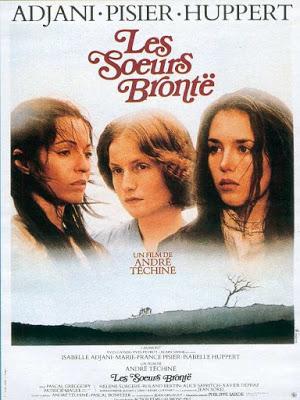 There were rumours a few years back of a film version of the life of the Brontë sisters, staring Jonathan Rhys Meyers as Branwell and that lady off Dawson's Creek as one of the sisters, but that doesn't seem to have come to anything. Other than a 1940s version of their life, Les Soeurs Brontë is the only cinematic attempt to bring the life of Emily, Anne and Charlotte (and Bramwell) Brontë to the screen. As the sharper among you will have noticed, it is in your actual French but has English subtitles and so my dear friend Miss Holman (resting assassin and good for bail money) bought it for me for my birthday...
There were rumours a few years back of a film version of the life of the Brontë sisters, staring Jonathan Rhys Meyers as Branwell and that lady off Dawson's Creek as one of the sisters, but that doesn't seem to have come to anything. Other than a 1940s version of their life, Les Soeurs Brontë is the only cinematic attempt to bring the life of Emily, Anne and Charlotte (and Bramwell) Brontë to the screen. As the sharper among you will have noticed, it is in your actual French but has English subtitles and so my dear friend Miss Holman (resting assassin and good for bail money) bought it for me for my birthday...
The Brontë Sisters, from the left Emily, Anne and Charlotte
(Isabelle Adjani, Isabelle Huppert, and Marie France Pisier)

Isabelle Huppert as Anne

Mia Wasikowska in Crimson Peak
Blimey, but everyone is everso lovely in the film, especially the ethereal Anne, who out of the three sisters could easily be overlooked as she didn't write either of the Brontë novels that people can immediately name. I have the impression that del Toro must have been aware of Huppert's styling in the film when bringing Edith Cushing to the screen (in Crimson Peak) or conversely the stylist for Les Soeurs Brontë also really like Millais' The Bridesmaid.
Emily strides around the moors, having a good wuther...
The film opens with Branwell completing the famous portrait of the sisters and himself, and it becomes immediately obvious that the family exists in a restricted space, all huddled together while the darkness gathers (much like in the painting). Emily pulls on trousers and scrambles over hill and dale, outraging elderly family members, but ultimately getting nowhere and returning to the parsonage. I particularly liked the scene where her sister shows her a beautiful wild rose which Emily spurns in favour of the holly, which will last longer. Just to prove her point, she stomps all over the rose. Nice.
Charlotte and Anne, writing among laundry...
We follow the sisters to Brussels, and to the home where Anne was the governess, but always back to Haworth, to the tiny parsonage which seems cold and quiet. The sisters are often shot with their backs literally against a wall, their costume different from the people around them (most extreme example of this being the opera scene at the end of the film). There are many scenes at night where the Brontës are crammed into the space carved for them by a guttering candle. There is an ever pervasive feeling of confinement, difference, captivity.
'Would it kill you to help with the laundry, Emily?'
The Brontë sisters are dressed beautifully, like little dolls, their diminutive size emphasised by their frankly massive dog. Branwell's descent into misery and failure is marvellously brought to screen by Pascal Greggory and his cheekbones. He manages to combine all the self-indulgent moping, drinking and more drinking of Branwell without being irritating, even when he sets his bed on fire. For heaven's sake. His profound inability to get away from Haworth is played as a very obvious foreshadowing of the sister's fate in a way I had not considered, and his demise (come on, that's not a spoiler, surely?) sets up the final part of the film. Possibly my favorite moment of the entire film, just for its sheer bleakness, has to be the sisters reading appalling reviews of Wuthering Heights out loud while Emily scrubs the scorch marks off Branwell's wall. Stunningly gothic.
Emily and Branwell, pretty and doomed
So, you know how it's going to end, and it's not cheery, but Les Soeurs Brontë is absolutely beautiful. Using the portrait of the siblings and Branwell's subsequent alteration of it as a reflection of the comparative fortunes of the family, this is a suffocating narrative of isolation, both intellectual and within society. All they have is each other, and as the film suggests, that is both their strength and their downfall. It makes Bright Star look like a gigglefest, so make sure you're feeling chipper when you watch it, but I can guarantee that you'll love it, if only for the proof that life is too short to do ironing...Les Soeurs Brontë (1979) is available from shops and the interweb now. Although mine was a French edition, the subtitles were easy to find.
